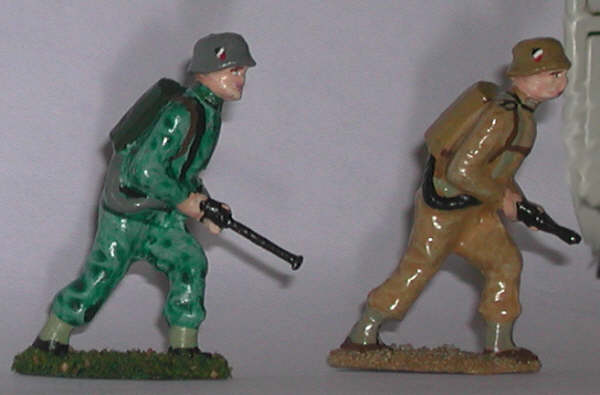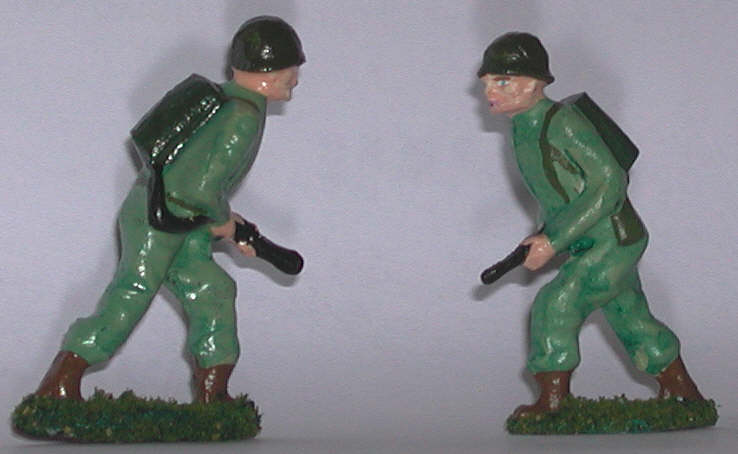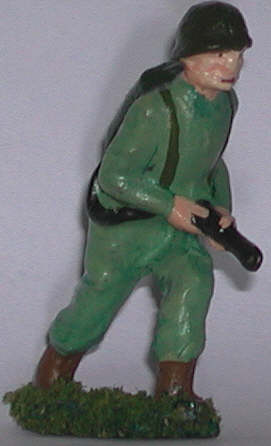
Copyright 2008 All Rights Reserved
The Flamethtrower Guy, Part 2
Now we come to the trick part. It is time for creative painting 101
Our Afrika Korps German was first. His flamethrower tank and helmet were painted a Mustard tan. His leggings were khaki tan, and his belts and field gear were done in a very pale "eucalyptus" green. The Afrika Korps leggings and web gear were issued in various shades, and they faded quickly. Belts and web gear could range from light khaki tan to mustard tan to olive green. The one consistent fact about Afrika Korps uniforms and gear was that they were not consistent at all.
The straps to hold the flamethrower were painted leather brown. Even if it had been blacked, the leather on heavy equipment would fade under frequent use. Many of the earlier-issued items had leather straps. Later the Germans used more cloth / webbing to make belts and straps.
A good touch is the national crest on the right side of the helmet. The piping on his epaullettes and collar is black, the color for engineers / pioneers. German flamethrower operators were engineer / pioneer troops.


Next, we will look at our Late War German. I wanted to get the effect of the Reed green summer uniforms. Most people only think of field grey. Reed green was also used. I tried using a flat gray base color, followed by a wash of Teal green. It could pass for either faded Reed green or a greener shade of field gray. The leggings were done in eucalyptus green. This hose was done in dark gray.
If you look closely, you can see that his field gear belt and suspenders are black. The flamethrower straps are brown. These details do not show up well on the figure, so you must add them with paint. The helmet was painted dark gray. German helmets in Europe could range from dark grey to a medium green all the way to a dark green that looks almost black. Troops in the same unit usually had the same color helmets.
The flamethrower tank was painted dark green. Germany painted most of its field equipment, from radio boxes to other large gear, in a dark green. Many people mistakenly assume that Germans used Panzer Grey for everything. Panzer grey was mainly a vehicular color.
Once again, we got the national crest on the helmet. Because flamethrower operators were drawn from engineer units, our soldier has black piping on his collar and epaullettes.
I replaced the molded nozzle with a small finishing nail / wire brad. I drilled out a hole and glued in the nail..For those so included to extra work, it looks more realistic the the molded-on nozzle.

Our American flamethrower men were much easier. Their field gear is any of various olive drab shades. There were three colors used for webbed gear during World War II: khaki tank, olive Drab #3 and Olive Drab #7. #3 was a medium shade, and #7 was darker. They quickly faded to any number of other shades, from sage green on up. Very little US equipment would have had a leather strap. The overwhelming majority had webbed straps. These would usually fade with frequent use.
As for solid items such as helmets and flamethrower tanks, the US Army and Marine Corps used dark olive drab. Once again, the shade could vary slightly. When I was in the Army, I had seen Olive Drab shades ranging from forest green to almost black.
|
 |
On this figure ,we painted an additional strap going under the arm. Note the deeply-flanged helmet rim. |
So there you have it. Our simple flamethorwer man included in the Castings metal mold # 5673 "Grenade throwers" is easily converted via Toy Soldier Art. He is too crude to be a hard-core military miniature, but he is just right for toy Soldier Art.
Contact Us at thortrains@comcast.net